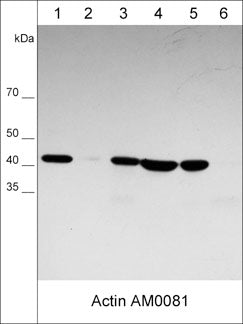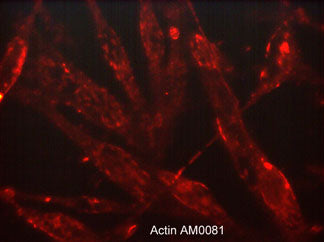Anti-β-Actin Antibody
- SPECIFICATION
- CITATIONS
- PROTOCOLS
- BACKGROUND

Application
| WB, IHC |
|---|---|
| Primary Accession | P60709 |
| Host | Mouse |
| Clonality | Mouse Monoclonal |
| Isotype | IgG2b |
| Clone Names | M008 |
| Calculated MW | 41737 Da |
| Gene ID | 60 |
|---|---|
| Other Names | Actin, b-actin, beta actin |
| Target/Specificity | Actin is a major cytoskeletal protein involved in diverse cellular functions including cell motility, adhesion, and morphology. Six different actin isoforms have been identified in vertebrates. There are four α isoforms: skeletal, cardiac, and two smooth muscle (enteric and aortic) actins, along with two cytoplasmic actins (β and γ). Actin exists in two principal forms, globular, monomeric (G) actin, and filamentous polymeric (F) actin. The assembly and disassembly of actin filaments, and also their organization into functional networks, is regulated by a variety of actin-binding proteins (ABPs). Phosphorylation may also be important for regulating actin assembly and interaction with ABPs. In Dictyostelium, phosphorylation of Tyr-53 occurs in response to cell stress and this phosphorylation may alter actin polymerization. In B cells, SHP-1 tyrosine dephosphorylation of actin leads to actin filament depolymerization following BCR stimulation |
| Dilution | WB~~1:1000 IHC~~1:100~500 |
| Format | Protein G Purified |
| Storage | Maintain refrigerated at 2-8°C for up to 6 months. For long term storage store at -20°C in small aliquots to prevent freeze-thaw cycles. |
| Precautions | Anti-β-Actin Antibody is for research use only and not for use in diagnostic or therapeutic procedures. |
| Shipping | Blue Ice |

Thousands of laboratories across the world have published research that depended on the performance of antibodies from Abcepta to advance their research. Check out links to articles that cite our products in major peer-reviewed journals, organized by research category.
info@abcepta.com, and receive a free "I Love Antibodies" mug.
Provided below are standard protocols that you may find useful for product applications.
Background
Actin is a major cytoskeletal protein involved in diverse cellular functions including cell motility, adhesion, and morphology. Six different actin isoforms have been identified in vertebrates. There are four α isoforms: skeletal, cardiac, and two smooth muscle (enteric and aortic) actins, along with two cytoplasmic actins (β and γ). Actin exists in two principal forms, globular, monomeric (G) actin, and filamentous polymeric (F) actin. The assembly and disassembly of actin filaments, and also their organization into functional networks, is regulated by a variety of actin-binding proteins (ABPs). Phosphorylation may also be important for regulating actin assembly and interaction with ABPs. In Dictyostelium, phosphorylation of Tyr-53 occurs in response to cell stress and this phosphorylation may alter actin polymerization. In B cells, SHP-1 tyrosine dephosphorylation of actin leads to actin filament depolymerization following BCR stimulation
If you have used an Abcepta product and would like to share how it has performed, please click on the "Submit Review" button and provide the requested information. Our staff will examine and post your review and contact you if needed.
If you have any additional inquiries please email technical services at tech@abcepta.com.













 Foundational characteristics of cancer include proliferation, angiogenesis, migration, evasion of apoptosis, and cellular immortality. Find key markers for these cellular processes and antibodies to detect them.
Foundational characteristics of cancer include proliferation, angiogenesis, migration, evasion of apoptosis, and cellular immortality. Find key markers for these cellular processes and antibodies to detect them. The SUMOplot™ Analysis Program predicts and scores sumoylation sites in your protein. SUMOylation is a post-translational modification involved in various cellular processes, such as nuclear-cytosolic transport, transcriptional regulation, apoptosis, protein stability, response to stress, and progression through the cell cycle.
The SUMOplot™ Analysis Program predicts and scores sumoylation sites in your protein. SUMOylation is a post-translational modification involved in various cellular processes, such as nuclear-cytosolic transport, transcriptional regulation, apoptosis, protein stability, response to stress, and progression through the cell cycle. The Autophagy Receptor Motif Plotter predicts and scores autophagy receptor binding sites in your protein. Identifying proteins connected to this pathway is critical to understanding the role of autophagy in physiological as well as pathological processes such as development, differentiation, neurodegenerative diseases, stress, infection, and cancer.
The Autophagy Receptor Motif Plotter predicts and scores autophagy receptor binding sites in your protein. Identifying proteins connected to this pathway is critical to understanding the role of autophagy in physiological as well as pathological processes such as development, differentiation, neurodegenerative diseases, stress, infection, and cancer.



